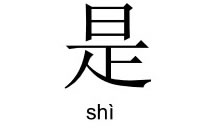Difference between revisions of "Language/Mandarin-chinese/Grammar/Connect-two-nouns-with-是-(shì)"
< Language | Mandarin-chinese | Grammar
Jump to navigation
Jump to search
| (4 intermediate revisions by the same user not shown) | |||
| Line 1: | Line 1: | ||
[[File:shi-chinese-polyglotclub2.jpg|thumb]] | |||
<div style="float:right">[[File:Zh-shì.ogg]]</div> | |||
In Chinese, 是 (shì) is used to connect nouns, and is rarely used with adjectives. | |||
==Structure== | ==Structure== | ||
| Line 33: | Line 35: | ||
Nà shì bēizi. | Nà shì bēizi. | ||
<blockquote>That's a cup.</blockquote> | <blockquote>That's a cup.</blockquote> | ||
Latest revision as of 22:35, 12 May 2022
In Chinese, 是 (shì) is used to connect nouns, and is rarely used with adjectives.
Structure[edit | edit source]
Here is the structure to connect names with 是 (shì):
Name 1 + 是 + Name 2
The Chinese language does not conjugate the verbs. As a result, the verb form is the same for all people using it, i.e. always “是 (shì)”.
It is very simple to form sentences expressing "to be" in Chinese; the only specificity of 是 (shì) is that it is used to link "two nouns" and therefore we can not really rely on literal translation from French when using the verb “to be”.
Examples[edit | edit source]
- 我 是 學生。/我 是 学生。
Wǒ shì xuéshēng.
I am a student.
- 她 是 医生。
Tā shì yīshēng.
She is a doctor.
- 他 是 老師。/他 是 老师。
Tā shì lǎoshī.
He is a teacher.
- 這 是 書。/这 是 书。
Zhè shì shū.
This's a book.
- 那 是 杯子。
Nà shì bēizi.
That's a cup.
